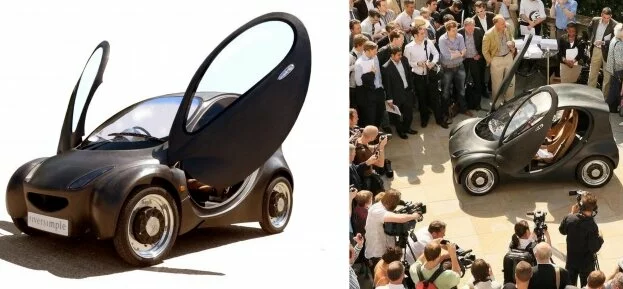Riversimple's Hydrogen Car
- Written by sanil
- Published in Automotive
- 0 comments

Nov 16, BBCN : A hydrogen-powered electric car under development in Wales is bringing more than just a C02-free powertrain to the table. Riversimple founder and chief engineer Hugo Spowers and his team are striving to upend the business model of making and selling – not to mention owning – cars.
Spowers is no stranger to challenging the status quo, having worked on the hydrogen-powered LIFECar, a demonstration hydrogen-powered vehicle developed by a consortium that included Morgan Motor, the defence contractor QinetiQ, Cranfield University and Oxford University.
Like that project, Spowers’ little Welsh startup is perhaps best represented by its prototype, an as-yet-unnamed, two-seat wonder of Smart Fortwo stature whose toylike form conceals radical innards. “We’ve designed a car around hydrogen fuel cells rather than trying to put fuel cells into cars designed around the internal-combustion engine for the last 100 years,” Spowers says.
Compressed hydrogen travels from a pressurised tank mounted at the rear axle to hydrogen fuel cells tucked in the car’s nose. The cells convert the fuel into electricity, which in turn powers four direct-drive motors, one housed in each wheel. The direct-drive equipment obviates Riversimple from having to fit a gearbox; drivers just push buttons on the dash for forward, neutral or reverse.
“There are no moving parts, except for the wheels,” Spowers says. “There’s no metal-to-metal contact, no lubrication required and no mechanical wear.”
Additional electricity is created via regenerative braking – whereby energy expended in slowing or stopping is recaptured rather than being lost as heat – and stored in a bank of supercapacitors that Spowers says will provide 80% of the car’s motive power down the road.
“That means the fuel cells only need to supply 20% of the power during acceleration,” Spowers notes. Conventional friction brakes intercede for higher-speed emergency stops and braking below 8kph (5mph).
“That means the fuel cells only need to supply 20% of the power during acceleration,” Spowers notes. Conventional friction brakes intercede for higher-speed emergency stops and braking below 8kph (5mph).
The prototype, which weighs about 520kg (1,147lbs) and measures 3.7 meters (roughly 12ft) long, scoots from zero to 50mph – its top crusing speed – in a respectable 8 seconds, Spowers claims, and has a driving range of about 300 miles before requiring refuelling.
While the final design is still being finalised, the demonstrator model reveals a sleek, light carbon-fibre body created by Chris Reitz, the company’s design chief. Reitz has put his stamp on many notable cars, including the Fiat 500, and has worked for Volkswagen, Audi, Nissan and Alfa Romeo. But Riversimple also differentiates itself in another key respect. Just as the Beatles observed that money can’t buy love, it can’t buy a Riversimple car, either.
This mobility-as-service approach is not new; the (now bankrupt) battery-swapping startup Better Place tried it, and Hyundai recently introduced a similar programme in the southwest US for its Tucson electric SUV, powered by hydrogen fuel cells. (A $499 monthly lease payment over three years covers all fuel and maintenance costs.) Spowers says that the monthly payment will also help subsidise the development of fuelling infrastructure.
While an exact fee remains undetermined, Spowers estimates it will total about £450 (roughly $720) – comparable to the monthly operating costs of a new, moderately priced car. Fees will vary according to how far consumers drive each month.
The principle may be difficult for consumers to grasp initially, Spowers concedes, but Riversimple ultimately expects motorists to gravitate towards a clean, viable alternative to ownership or conventional leasing schemes. Beta testing of 20 vehicles is slated for late 2015, with production expected to start in mid-2017.
Tagged under
- Hydrogen Car
- car
- technology
Related items
- Speeding car ram in to electric transformer, one injured
- Car rams over four vehicles as driver try to attend mobile call
- ‘Dozens dead’ as car bomber hits Houthis
- Speeding car creates rampage in Tadambail
- Tata Indigo car catches fire near Mangalore airport parking lot


